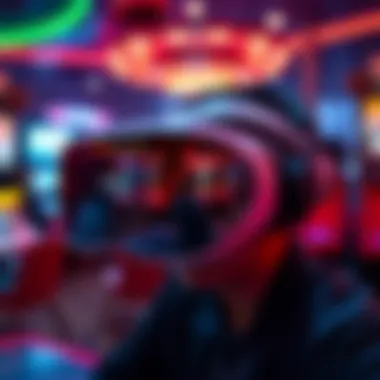Exploring VR Rooms in Las Vegas: A Guide


Intro
Virtual reality (VR) rooms in Las Vegas offer a unique blend of cutting-edge technology and immersive experiences that have transformed the landscape of entertainment. The Las Vegas Strip is not just known for its glittering casinos and surreal shows; it has become a hotspot for VR enthusiasts and casual players alike. In this bustling city, VR rooms serve as a new frontier for gaming, fostering an atmosphere where people can come together to interact, compete, and explore fantastical realms that extend beyond the confines of reality.
As the VR technology evolves, so too do the games and activities available, leading to a diverse array of experiences that cater to anyone from the curious novice to the seasoned gamer. The implications of these VR experiences extend beyond mere entertainment; they shape social interactions, communities, and behaviors in fascinating ways. In this guide, we will delve deeply into the dynamics of these VR rooms, examining their technology, popular offerings, and the ways in which they influence gaming culture.
This detailed exploration will not only inform but also equip readers with insights on how to navigate these exciting spaces. Whether you're a casual player looking for a fun outing or someone whose pursuit lies in mastering the latest VR challenges, understanding the operational aspects of these rooms is crucial. Let's embark on this journey into the heart of VR gaming in Las Vegas.
Intro to VR Rooms in Las Vegas
Virtual reality rooms are more than just a passing fad in the entertainment landscape of Las Vegas; they represent an evolving frontier in both gaming and social interaction. As technology intertwines more with leisure, these spaces offer a unique blend of immersion and excitement, attracting a diverse range of visitors from casual gamers to avid tech enthusiasts. Understanding what VR rooms bring to the table is essential for anyone looking to explore the full scope of entertainment options in this iconic city.
Concept and Definition of VR Rooms
At its core, a VR room is a dedicated space where individuals can engage in fully immersive virtual environments, crafted by sophisticated technology. This definition, however, scratches only the surface. These rooms typically boast advanced hardware, like headsets and sensing devices, enabling participants to step into a realm where their actions feel consequences as tangible as in real life.
Typically, VR rooms utilize high-end systems, and one can expect to encounter setups powered by companies like Oculus or HTC, pushing the boundaries of interactive experiences. The beauty of these rooms lies in their capacity to transport users away from the real world, whether it's battling foes in a highly competitive game or roaming serene landscapes.
In broader terms, VR rooms can encompass various themes and activities, from gaming to educational simulations and even fitness classes, engaging visitors in ways traditional venues do not. As technology matures, these spaces stand at the forefront of redefining group entertainment.
Historical Context of VR Technology
The journey to current VR experiences traces back decades, embedding itself in the pages of technological history. Early experiments with virtual reality began in the mid-20th century, with devices like the Sensorama in the 1960s, designed to simulate multi-sensory experiences. Fast forward to the 1980s and 90s, when more sophisticated setups began to surface, albeit often limited and cumbersome. These developments predominantly marked niche areas in science or military training rather than mainstream entertainment.
As time progressed, the turn of the millennium saw important strides in technology, which laid the groundwork for contemporary VR. Companies focused on lowering barriers to entry, making VR accessible to the average consumer. Mention of the Virtuality group and their arcade games in the early 90s is often a topic of fond nostalgia yet highlights the potential of VR as a social experience.
With advancements in computing power, alongside the introduction of devices like the Oculus Rift in 2012, VR began carving out a notable space in entertainment. Las Vegas emerged as an early adopter of these technologies, fusing old-school gambling with high-tech gaming experiences. This synergy has spurred a renaissance within the tourism industry, inviting a new audience to explore both gaming and social interaction in dynamic ways.
As these trends continue to unfold, VR rooms in Las Vegas will likely evolve alongside societal preferences, creating rich new narratives in the gaming sector and redefining how we interact with both virtual and real worlds.
Technological Underpinnings of VR Rooms
Understanding the technology behind VR rooms is crucial for grasping how they operate and the experiences they offer. Factors like hardware and software advancements shape these immersive environments and enhance visitor engagement. VR rooms in Las Vegas are not just a futuristic gimmick; they're platforms for unique interactions and adventures that elevate the concept of entertainment.
Hardware Components of VR Systems
The foundation of any VR experience lies in its hardware. At the heart of this technology are various components that work in tandem to create an immersive experience. Key elements include:
- Headsets: Devices like Oculus Quest and HTC Vive are notable in the VR space, providing high-definition visuals and 360-degree viewing angles. Their design focuses on comfort, allowing players to wear them for extended periods without discomfort.
- Controllers: Motion controllers allow users to interact with the virtual environment. These devices track hand movements, enabling users to pick up objects, shoot, or solve puzzles, creating a sense of agency that’s hard to match.
- Tracking Systems: Systems like infrared sensors or external cameras track user movements, ensuring that actions in the real world translate accurately to the virtual one. This aspect significantly enhances the feeling of presence.
- Computing Power: High-performance computers or consoles are needed to run complex VR applications smoothly. These systems require powerful GPUs to render visuals in real time, ensuring a responsive experience that minimizes latency and maintains immersion.
By prioritizing the integration of cutting-edge hardware, VR rooms present a seamless blend of technology that captivates and entertains visitors.
Software Innovations and Game Development
Once the hardware is set in place, the next crucial layer is the software that powers the VR experiences. This includes the programs that control the VR environments and games available in these rooms.
- Game Engines: Tools like Unity and Unreal Engine are pivotal in developing VR content. These engines allow developers to create visually stunning worlds with interactive scenarios that feel lifelike and engaging. They are essential for shaping the user experience within VR.
- Multiplayer Integration: Software now often supports multiplayer environments where users can interact with each other, even if they are in different physical locations. This fosters a deeper level of social interaction, as players collaborate or compete in real-time.
- User-Generated Content: With advancements in software, many platforms now allow users to create and share their content. This not only enhances player engagement but also extends the longevity of experiences available in VR rooms.
- Regular Updates and Expansions: A successful VR room frequently updates its software to introduce new content, ensuring that experiences remain fresh. This is vital in keeping players coming back for more, as they explore new challenges and environments.
In essence, the technology that underpins the VR experience isn't static; it's a rapidly evolving field that combines hardware and software advancements to shape the landscape of entertainment in Las Vegas.


As technology continues to grow, so too does the potential of VR experiences. Each innovation opens new doors for creativity and interaction, keeping Las Vegas at the forefront of gaming culture.
Types of VR Experiences Available
Understanding the types of VR experiences available is crucial in grasping how these innovative rooms have carved out a niche in the bustling landscape of Las Vegas. As technology evolves, so do the experiences that VR rooms offer, making it essential to explore the varying formats. Each type provides unique interactive avenues that cater to different preferences and tastes. The diversity not only enhances entertainment value but also fosters social connections among participants.
Multiplayer Gaming Experiences
Multiplayer gaming experiences in VR rooms create an electrifying atmosphere where players can engage in teamwork or fierce competition. Picture this: friends stepping into a virtual battlefield, strategizing and coordinating to come out on top, all while donning sleek headsets and gripping controllers. The social dimension is amplified, as players can cheer each other on or engage in friendly banter—a stark contrast to traditional gaming at home.
These settings often host a range of games from action-packed shooters to elaborate fantasy quests. Here’s the kicker: many establishments cater to large groups, allowing up to sixteen participants or more at once. This capability transforms the gaming experience from solitary to communal, fostering camaraderie.
"Social gaming is not just about competition; it's about the bonds formed in the heat of battle and the laughter shared over shared victories and losses."
The potential for collaboration is immense. Gamers must communicate and devise strategies, enhancing critical thinking along with teamwork skills. Additionally, a dynamic spectator experience can be integrated, allowing onlookers to cheer for players in real-time. Such interaction enriches the environment, blurring lines between observer and participant.
Escape Rooms and Problem-Solving Challenges
Escape rooms in VR have taken the classic concept and flipped it inside out, merging physical presence with virtual elements. Players find themselves in a series of intricately designed scenarios where critical-wit is their best ally. Be it escaping a derelict spaceship or solving a murder mystery in an eerie mansion, the immersive environment invokes a thrill like no other.
Participants need to work through puzzles and riddles, often under time constraints, prompting quick thinking and collaboration. This aspect is not just for fun; it enhances cognitive abilities and promotes social interaction through shared problem-solving. The rich graphics and engaging narratives elevate the experience, making it feel not just like a game but a lifelike adventure.
As players delve into these scenarios, they are often surprised by the layered storytelling. The overarching narrative hooks them in while requiring them to keep their wits about them. Today, many VR spots offer unique themes and ever-changing challenges, ensuring repeat visitors have fresh experiences each time they return.
Simulation and Immersive Environments
Simulation and immersive environments represent the frontier in VR experiences, pulling visitors into realms that challenge their perception of reality. Here, the experiences can range from flight simulators that engage aviation enthusiasts to hyperrealistic environments where users can practice skills—be it architecture, mechanical repairs, or even surgery—in an authentic yet controlled space.
Imagine stepping into a faithfully recreated historical event or a future cityscape. The level of detail can transport users to another time or place, creating discussions that go far beyond casual gaming. These types of experiences also have educational potential. Schools and institutions are increasingly incorporating VR simulations into curricula, making learning interactive and relevant.
Moreover, these environments adapt based on user reactions, tailoring experiences and optimizing engagement. The potential here is vast, making each visit unique based on personal choice and exploration.
In summary, the variety of VR experiences available in Las Vegas is a vibrant tapestry of technology and interaction. Whether one’s interest lies in cooperative gaming, strategic challenges, or simulations, there’s something to satisfy every craving. As this area continues to develop, the opportunities for fun and connections will only expand.
VR Rooms as Social Venues
Virtual reality rooms are not just about immersive experiences or escape from reality; they have transformed into vibrant social venues where people engage, connect, and share memorable moments. The importance of these spaces hinges on their unique ability to bridge the gap between the physical and digital worlds, effectively fostering a sense of community and interaction among players. Las Vegas, a city synonymous with entertainment and socialization, provides an ideal backdrop for this phenomenon. Here, VR rooms serve as a modern gathering place for diverse audiences, and understanding this aspect reveals much about the broader implications for social gaming culture.
Fostering Community and Interaction
In the heart of Las Vegas, VR rooms act as a melting pot for individuals from all walks of life. Whether they are avid gamers, curious tourists, or even local businesses hosting networking events, these spaces encourage interaction in ways conventional social venues cannot. One cannot dismiss the serendipity afforded by shared experiences in a virtual realm. When players don their headsets and step into a digital universe, they are often met with strangers who quickly become teammates or rivals.
The community aspect of VR rooms is critical. They often host tournaments, themed events, or social nights that draw people out of their shells. For instance, VR events allow participants to mingle over shared goals, like escaping from a virtual dungeon or winning a race. Bridging the gap through cooperation or competition often leads to genuine bonds, extending beyond just the gameplay.
Moreover, many VR establishments have integrated platforms for ongoing engagement, such as community boards or chat groups on sites like Reddit. These impactful tools for interaction help cultivate relationships that may not merely exist within the confines of the gaming booth.
Group vs. Solo Experiences
Choosing between group or solo experiences in VR rooms can feel like picking between a night at the slots or a cozy poker game. Each choice offers distinct flavors and benefits that cater to different types of social interactions and personal preferences.
- Group Experiences: When players opt for group sessions, they dive into a dynamic environment that fosters teamwork and strategy. The collaborative nature of multiplayer games, such as "Arizona Sunshine" or "Rec Room," creates a natural camaraderie. For instance, teaming up to complete objectives in a cooperative shooter can forge connections as players celebrate victories or strategize through challenges together.
- Solo Experiences: On the flip side, engaging in a solo session in VR can be equally rewarding. Games like "Beat Saber" or "Half-Life: Alyx" allow players to immerse themselves in personal worlds of adventure and creativity. Although these solo ventures may lack the group dynamics, they provide a space for self-exploration and skill development. Players often return to socialize about their individual journeys, sparking conversations rooted in shared, yet private, experiences.


In Las Vegas, the choice is yours to make. Many VR rooms are designed to accommodate both styles, encouraging guests to find what fits best for their mood or group. As the atmosphere encourages mixing and mingling, it’s likely that even the most dedicated solo players will stumble into a group dynamic.
Analyzing the Market Trends
Understanding the market trends related to VR rooms in Las Vegas is crucial for various stakeholders, including gamblers, casino employees, poker players, industry analysts, and content creators. Grasping these trends not only allows for strategic planning but also helps forecast future directions for investment, technology adoption, and customer engagement. As the gaming landscape continuously shifts, those involved in the industry must stay informed to adapt and thrive.
Growth of VR Rooms in Las Vegas
The growth of VR rooms in Las Vegas exemplifies a burgeoning sector within the broader entertainment and gaming industry. Recent studies indicate a robust increase in VR experiences, with the number of VR establishments rising steadily. Factors contributing to this surge include the rapid advancements in VR technology and the city's reputation as a hub for innovation.
Key Factors Driving Growth:
- Technological Advancements: Developments in hardware, such as headsets like the Oculus Quest 2 and HTC Vive, ensure more immersive experiences and easier access for users.
- Diverse Offerings: From multiplayer gaming formats to escape rooms, the variety of VR experiences appeals to wide audiences. This versatility helps attract not only gaming enthusiasts but also casual visitors, significantly broadening the customer base.
- Strategic Partnerships: Collaborations between VR companies and established casinos have enhanced visibility and accessibility. These partnerships help blend traditional gaming elements with new technologies, tapping into existing clientele.
The rise of VR rooms also correlates with the changing demographics of visitors to Las Vegas, where younger audiences seek unique entertainment options that deviate from conventional casino offerings. As the preference shifts towards immersive experiences, businesses that adapt quickly can benefit significantly.
Investment and Profitability Analysis
Investment in VR rooms represents a strategic move in the competitive landscape of Las Vegas entertainment. Market dynamics reveal several noteworthy aspects regarding profitability and future sustainability of these ventures.
Considerations for Investment:
- Initial Costs vs. Long-term Returns: While the initial costs for setup can be steep—covering equipment, software, and venue modifications—the potential for long-term returns exists as demand grows.
- Audience Engagement: VR rooms often yield higher engagement rates than traditional gaming environments. Engaged customers tend to spend more, leading to better profitability metrics.
- Market Saturation Risks: As more VR rooms enter the market, there's a risk of over-saturation. Careful analysis of location and target demographics is essential for ensuring sustainable growth.
Profitability Indicators:
- Revenue Streams: Various revenue streams, including ticket sales, subscriptions, and in-game purchases, contribute to the overall financial viability of VR rooms.
- Customer Retention: The immersive nature of VR experiences often encourages repeat visits, enhancing customer lifetime value.
- Marketing Strategies: Innovative marketing techniques, such as social media promotions and influencer partnerships, can drive traffic and increase visibility, leading to higher profits.
"Engaging in the VR realm is more than just gaming; it's about crafting memorable experiences that keep customers coming back."
For further insights into VR technology and trends, you may find useful resources at Wikipedia or Britannica.
Challenges in the VR Room Experience
The increasing popularity of VR rooms in Las Vegas is evident, yet it's vital to explore the hurdles that accompany this technological breakthrough. Understanding the challenges faced in VR room experiences not only informs current users but also guides operators in improving their services. Recognizing limitations can bolster the evolution of this medium. \ \
Technical Limitations and Issues
One of the primary challenges encountered in VR rooms revolves around hardware and software limitations. High-quality visual rendering often demands costly hardware, such as powerful graphics cards and state-of-the-art headsets.
For instance, an older headset might lack the resolution to provide an immersive experience. This can lead to pixelation—a bit of a buzzkill for enthusiasts. Moreover, server issues or compatibility problems with certain games can result in lag, leading to frustration among users. An inconsistent frame rate can make virtual environments feel choppy, eradicating the immersion VR aims to achieve.
Some users have even reported experiencing difficulty in calibration, especially with motion controllers. An imprecise calibration can lead to a clumsy experience, where players struggle with controls. This underscores a significant need for reliable setups and regular maintenance to mitigate hardware wear and tear.
\
User Experience Concerns
Apart from technical issues, there are substantial user experience concerns that cannot be overlooked. Firstly, the physical space of a VR room may not always accommodate a group’s size efficiently. Some setups provide limited movement space, which can restrict interactions. Crowded conditions can lead to a lack of comfort and concentration, inhibiting the overall enjoyment of the experience.
Furthermore, the potential for motion sickness looms large in VR use. Individuals who are sensitive to motion may find themselves quickly overwhelmed, leading to discomfort or nausea. To address this, VR establishments need to make adjustments, such as incorporating short breaks into longer sessions or providing extensive guidelines on how to acclimate oneself before diving into intense gaming scenarios. \
Infrequently, users might also encounter barriers around accessibility. VR technology can create challenges for individuals with specific needs or disabilities. Some VR games and setups do not provide sufficient adaptations, leading to exclusion rather than inclusivity. All these factors indicate that continuous efforts are necessary to enhance the user experience and cater to a wider audience.
\
Health and Safety Considerations
As the popularity of VR rooms in Las Vegas continues to escalate, attention must be directed towards the health and safety aspects of these immersive environments. These concerns are not merely peripheral; they are foundational for fostering a positive and thrilling experience. By addressing potential hazards, both operators and users can ensure a safer, more enjoyable time that stretches beyond mere entertainment. Understanding these considerations is crucial for the overall success of VR experiences.
Physical Safety in VR Environments


Physical safety measures in VR arenas encompass a variety of factors, ranging from equipment integrity to spatial awareness. Participants often wear headsets that block their view of the real world, which can lead to accidents if the surrounding area isn’t sufficiently clear or properly marked. Thus, businesses operating VR venues must adopt stringent safety protocols. Here are key elements to consider:
- Space design: Rooms need ample space for movement, reducing the chance of collisions.
- Clear signage: Instructions and warnings should be prominently displayed, guiding users to avoid potential pitfalls.
- Staff supervision: Trained personnel should be available to monitor participant movements and provide assistance if needed.
Regularly maintaining equipment also plays an integral role. A well-kept VR headset and controllers ensure that the technology functions without hitch, minimizing risks of sudden malfunctions that could lead to accidents.
"Safety is not just a priority but an operational requirement to enjoy the full breadth of VR experiences."
Addressing Motion Sickness and Discomfort
Motion sickness is another critical consideration in the realm of virtual reality. Many users encounter discomfort due to the disconnect between visual input and physical reality, which can lead to symptoms such as dizziness and nausea. With a better understanding of this issue, VR operators can tailor experiences that lessen these symptoms and enhance user satisfaction. Below are some strategies:
- Session duration management: Limiting the time spent in VR can greatly reduce the onset of discomfort. Keeping sessions short allows users to acclimate more easily without overwhelming them.
- Adjustable settings: Offering customizable options like field of view (FOV) and motion sensitivity can help tailor the experience to individual sensitivities, making it easier for users to engage without adverse effects.
- Breaks and cooldowns: Encouraging users to take regular breaks and reorient themselves can aid in preventing the onset of motion sickness.
Operators have a responsibility not only to enhance entertainment value but also to safeguard the well-being of participants. Striking this balance is essential for the longevity and reputation of VR rooms in the bustling atmosphere of Las Vegas.
For more information on physical safety in VR and sessions, see Wikipedia - Virtual Reality. For insights into managing motion sickness, consider visiting Reddit - Motion Sickness in VR.
By closely examining health and safety considerations, the VR industry can cultivate environments that are not only enjoyable but also safe for all participants.
The Future of VR Rooms
As we peer into the crystal ball of technology, it's clear that the future of VR rooms holds incredible promise and potential. With innovations surging ahead, the landscape of virtual reality is set to evolve dramatically. This section explores why this topic is relevant to the current discourse, spotlighting the anticipated advancements, benefits, and considerations surrounding VR spaces.
Predicted Developments in VR Technology
The trajectory of VR technology isn’t merely bound by the limits of current hardware and software. Rather, we are on the verge of breakthroughs that will redefine experiential engagement. Here are some notable predicted developments:
- Enhanced Visual Fidelity: New display technologies resembling the quality of augmented reality lenses like Apple's Vision Pro could push the boundaries. Expect resolutions that mimic human vision, delivering stunning realism.
- Improved Motion Capture: Advanced sensor technology will allow seamless movements within VR environments, reducing latency and making interactions feel more natural. This will enable experiences that blend physicality with digital realms more effectively than before.
- AI Integration: Artificial intelligence has the potential to customize VR experiences on-the-fly. Intelligent NPCs (non-playable characters) learn from player behavior, adapting their tactics for a more immersive challenge.
- Wireless Freedom: The shift to wireless technology will eliminate cumbersome cables, paving the way for fully immersive experiences. Without being tethered, users can engage freely in their surroundings, enhancing spatial awareness.
"As VR evolves, users might one day find themselves stepping into a simulation indistinguishable from real life. Creativity knows no bounds!"
These technologies aren't merely exciting; they also serve practical needs, allowing visitors to become more invested in their virtual encounters.
Potential Market Expansions Beyond Gaming
While gaming has been a significant driving force behind the expansion of VR rooms, it is far from the only sector ripe for exploration. The future could see VR applications flourish in numerous avenues:
- Education and Training: Perhaps the most compelling is in educational environments, where VR can simulate complex scenarios. Think about medical students practicing surgery without real-world consequences or corporate training that immerses learners in realistic workplace simulations.
- Tourism: Virtual travel experiences could allow people to explore landmarks around the globe without leaving their homes. Tourist hotspots might recreate local vibes, giving people a glimpse into foreign cultures.
- Real Estate: Virtual property tours are becoming commonplace, but future developments may include fully interactive walkthroughs. Buyers could traverse potential homes or even redesign spaces to visualize possibilities.
- Fitness: Gyms and personal training could integrate VR environments that make workouts engaging and diverse. Imagine cycling through scenic routes around the world while physically at a local gym.
Culmination
The exploration of VR rooms in Las Vegas offers a fascinating glimpse into the intersection of technology, gaming, and social interaction. It’s not merely about immersive experiences; it’s about the profound impact on the gaming landscape. The underlying technology facilitates diverse applications, engaging both casual patrons and dedicated enthusiasts. The VR experience isn’t simply an entertainment alternative; it's reshaping how people socialize and interact in the vibrant city.
Summative Thoughts on VR in Las Vegas
As we consider the implications of virtual reality within Las Vegas, a few key thoughts come to the forefront. First and foremost, the variety of experiences offered through VR rooms caters to a broad audience. From multiplayer adventures to immersive story-driven narratives, each VR room encapsulates distinct user experiences that appeal to different preferences. Moreover, these environments have become a social hub, promoting interactions that extend beyond traditional gaming. The communal aspect fosters a sense of belonging, turning these rooms into more than just gaming spaces—rather, they evolve into gathering spots for people from all walks of life.
Furthermore, as technology continually advances, the offerings within these rooms are likely to evolve dramatically. Innovations in graphics and interaction mechanics could create wholly new types of experiences, further enriching the Las Vegas gaming scene. The foundations built today might lead to a more intricate future, where virtual reality plays a central role in entertainment.
Encouragement for Deeper Exploration
As the VR landscape in Las Vegas continues to unfold, it's vital for players and industry professionals alike to delve further into this realm. Engaging with VR rooms provides not just entertainment, but also insights into consumer preferences and emerging technologies.
Consider participating in different types of VR experiences, attending industry seminars, or simply discussing with others what they find fascinating about these rooms. Resources like Wikipedia or Reddit's VR communities can be beneficial for discovering trends or insights that might not be readily available elsewhere.
Ultimately, immersing oneself into the VR wave in Las Vegas promises thrilling adventures and invaluable insights into the future of gaming and social interaction. Keep an open mind and embrace the rapidly changing dynamics as this technology continues to paint new possibilities onto the canvas of entertainment.















